There's no deck quite as efficiently disruptive as Michael Hamilton’s iteration of Iyslander, dubbed Bullander. Michael debuted the Bullander strategy during 2022 U.S. Nationals and shocked the world with the deck, winning that tournament, Worlds 2022, and just a few weeks ago The Calling: Indianapolis - firmly cementing Bullander as one of the best decks in the game and the best way to build Iyslander.
I’ve been playing Iyslander since day 1, and I’ve been borderline obsessed with her since she was introduced in Everfest. Although I recognized the power and efficiency of Bullander, that version of the deck didn’t quite click with me. As a Wizard player, the blend of attack actions and Instant speed plays didn't resonate with me.
Enter, the Weathervane.
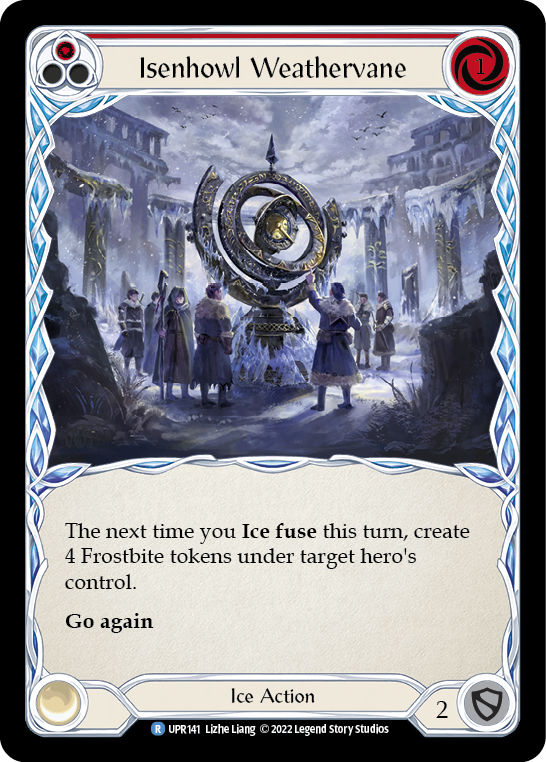
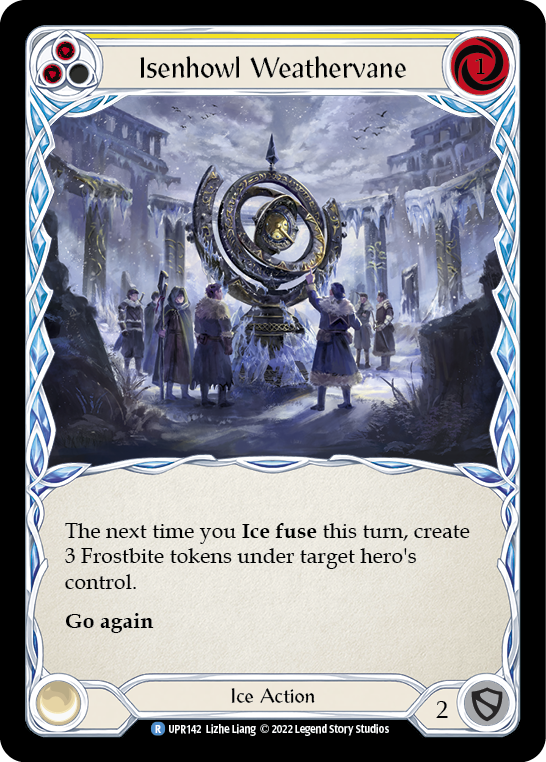
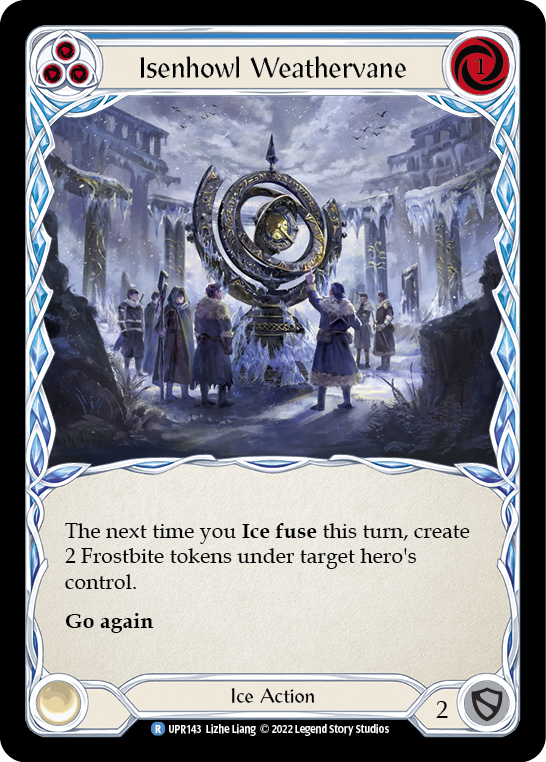
As Bullander was sweeping the scene, I was working on and tuning a version of a Classic Constructed Iyslander deck focused around Isenhowl Weathervane. Coming in a cycle of all three colors, Isenhowl Weathervane costs 1 resource and creates frostbites when you Ice fuse. It’s also an Ice action with go again.
In general, Uprising's pool of Ice/Wizard cards are slightly below-rate, with various effects keyed off an Ice fusion. I immediately honed in on Ice Eternal and Freezing Point as cards with massive potential.
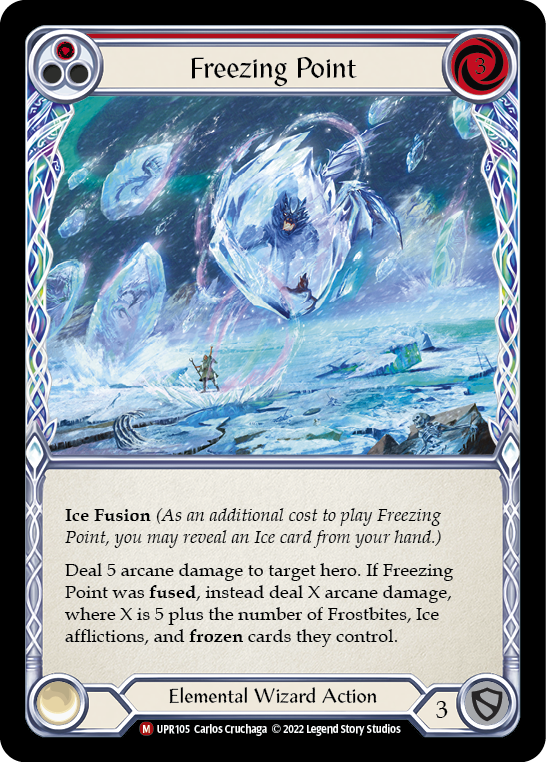
Freezing Point costs 3 and does 5 arcane damage. But if it’s Ice fused, it does 5+X, where X is the addition of frosbites, Ice afflictions and frozen cards your opponent controls. I just knew I had to find a way to exploit this card to it’s fullest. Freezing Point has one of the highest ceilings for a Wizard action in the game (I consider it to be Iyslander's version of Blazing Aether). At its base, Freezing Point is completely below rate at 3-for-5; but its ceiling can reach in the 20’s with a little bit of work.
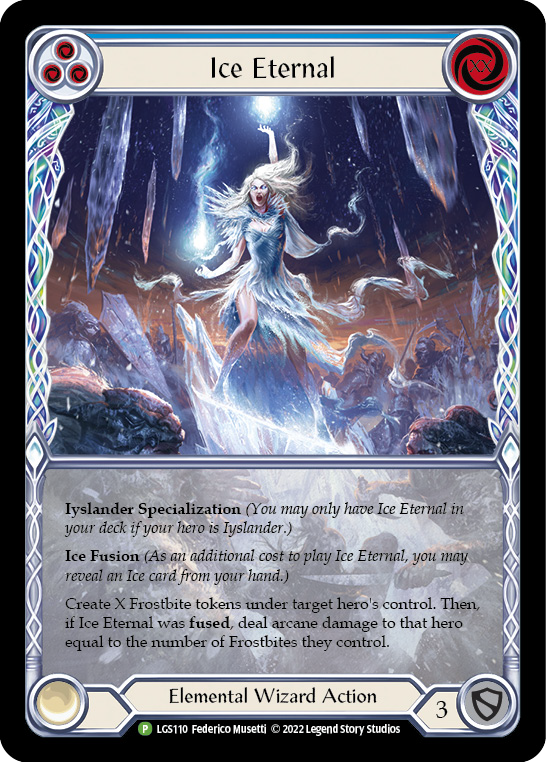
Ice Eternal is another card that’s just rife with possibilities for exploitation. Initial strategies included pitching as many resources into it as possible with a couple Energy Potions; but while Ice Eternal can create frostbites of it’s own, the card only cares about how many frostbites your opponent controls, not how they got those frostbites. Combining Ice Eternal with Isenhowl Weathervane can be a much more efficient way to buff it up than dumping a hand full of blues.
These cards worked in tandem to form the core of the deck's gameplay.
The Deck
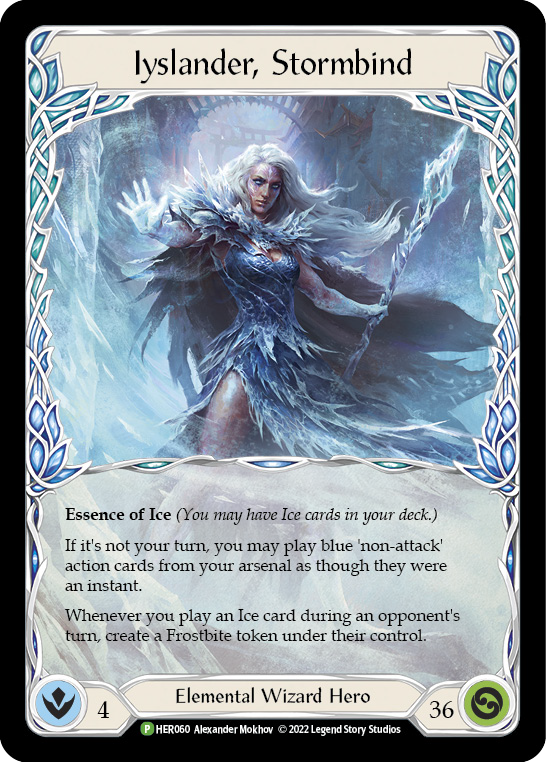
Weapons
- Waning Moon (1)
Equipment
- Coronet Peak (1)
- Fyendal's Spring Tunic (1)
- Nullrune Hood (1)
- Ironhide Gauntlet (1)
- Storm Striders (1)
- Metacarpus Node (1)
Loadout
- Frosting (Blue) (3)
- Channel Lake Frigid (Blue) (3)
- Energy Potion (Blue) (2)
- Ice Eternal (Blue) (3)
- Freezing Point (Red) (3)
- Isenhowl Weathervane (Red) (3)
- Isenhowl Weathervane (Blue) (2)
- Isenhowl Weathervane (Yellow) (3)
- Cold Snap (Blue) (3)
- Arctic Incarceration (Blue) (3)
- Aether Hail (Blue) (3)
- Icebind (Blue) (3)
- Aether Icevein (Red) (3)
- Aether Icevein (Yellow) (3)
- Exposed to the Elements (Blue) (3)
- Encase (Red) (3)
- Polar Blast (Blue) (3)
- Polar Cap (Red) (3)
- Brain Freeze (Blue) (3)
- Fyendal's Fighting Spirit (Yellow) (2)
- Nourishing Emptiness (Red) (1)
- Insidious Chill (Blue) (3)
- Frost Hex (Blue) (3)
- Heart of Fyendal (Blue) (1)
- Scour (Blue) (2)
- Winter's Bite (Blue) (3)
- Blizzard (Blue) (3)
The core strategy to the Weathervane deck is simple: present as much disruption as possible to your opponent every turn and lock them out of the game; or 'Time Walk' them (a term coined by M:tG meaning 'take an extra turn') so they can’t possibly return volley with any significant force. Disruption comes in the form of frostbites and taxing effects, which you can then angle into damage with Frost Hex.
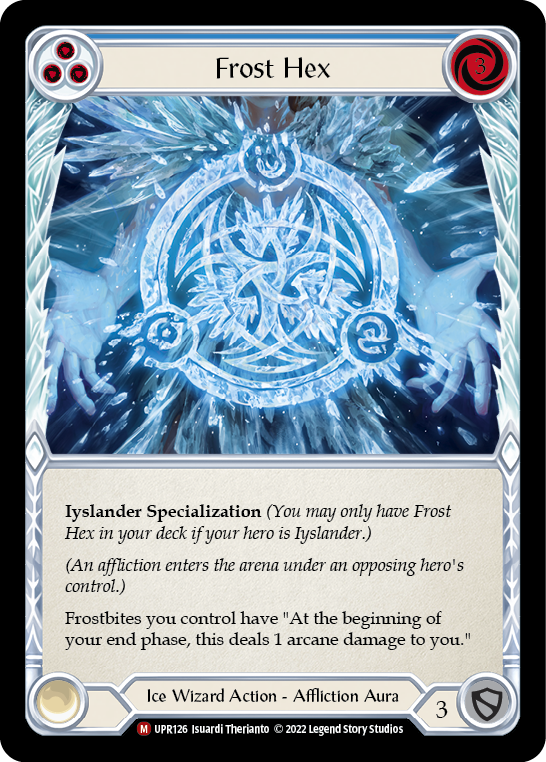
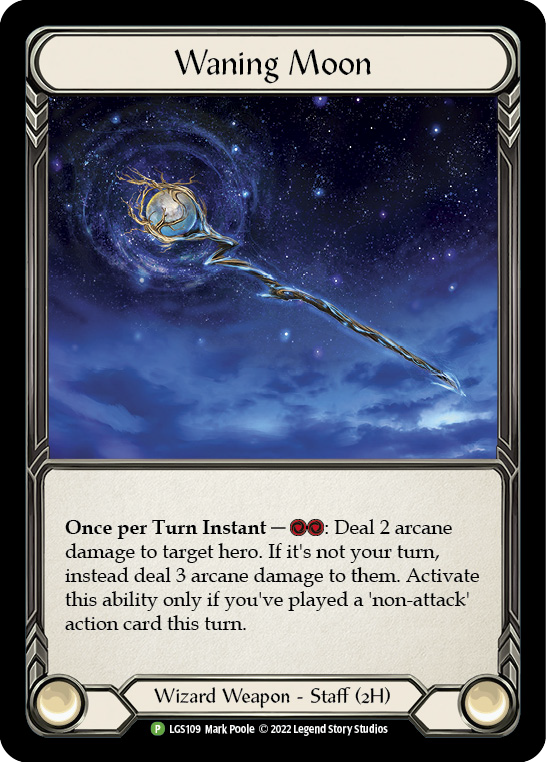
This deck runs only one weapon: Waning Moon. This weapon may seem innocuous at first, but if you pair it with Iyslander’s hero ability that grants her the power to play blue non-attack action cards from arsenal at instant speed on your opponent's turn, Waning Moon becomes a powerhouse. Being able to deal 5 arcane damage at instant speed over an entire turn cycle is incredibly disruptive and presents your opponent with difficult blocking decisions, both on your turn and their turn. The efficiency and synergy of Waning Moon in this deck makes it the only weapon I use.
The main strategy of this deck is playing efficient 0- and 1-cost blue non-attack actions from arsenal on your opponent's turn, like Cold Snap and Winter’s Bite. Turning on Waning Moon is incredibly easy; and spending a blue pitch for a frostbite, some disruptive effect and 3 arcane damage at instant speed is very efficient.
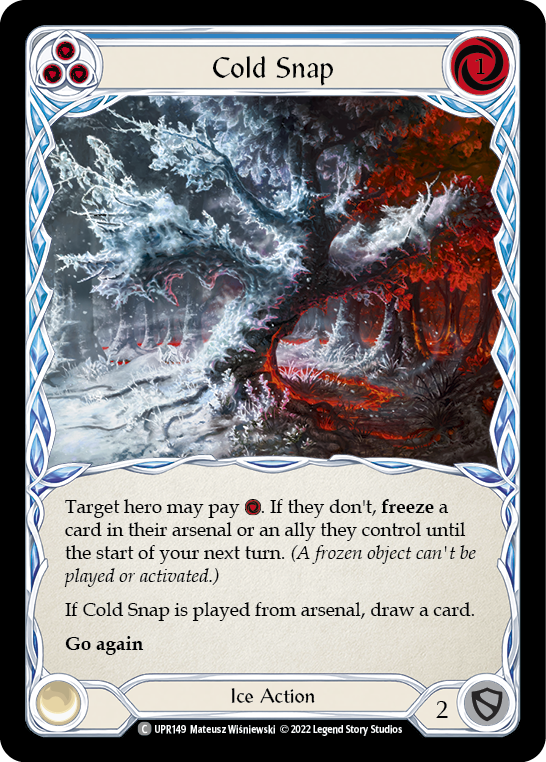
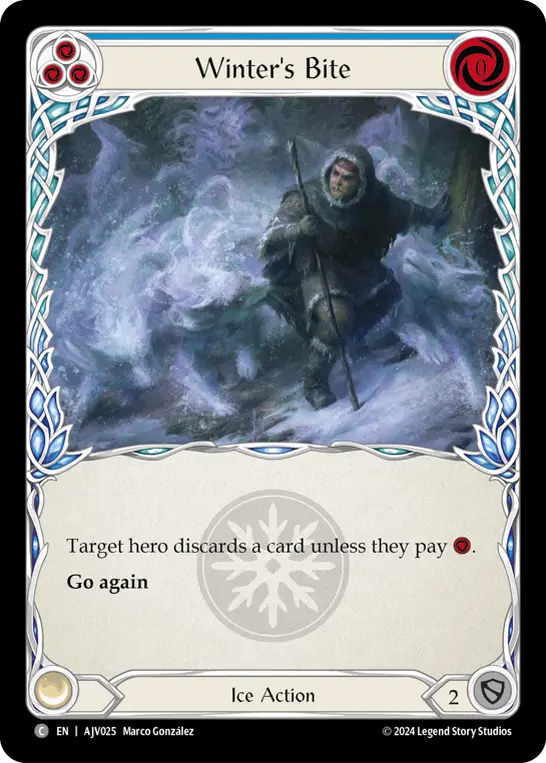
Storm Striders is immensely critical to a Wizard's identity. For those unfamiliar with the play patterns of the class, its ability may seem lackluster at first; but being able to play a non-attack action card at instant speed, regardless of the color or if it’s in your hand or arsenal, essentially lets a Wizard take an extra turn. Being able to interrupt your opponents turn with a spell, often threatening lethal arcane damage and usually while they're overextended in an attempt to kill you, means your spell will resolve first because of how layering on the stack works and resolves. If you interrupt their offense with an instant speed spell and deliver a lethal dose of arcane damage, your damage resolves first and therefore your opponent's life hits 0 before yours does. Iyslander can already deal arcane damage to the opponent at instant speed on their own turn thanks to her hero ability and Waning Moon; but the ability to extend that further and use red pitch spells with Storm Striders means her lethal reach is even higher and more efficient, making Storm Striders the only pair of boots you should be wearing.
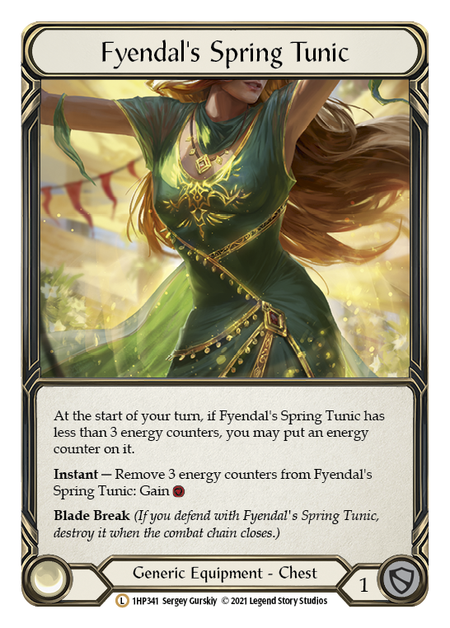
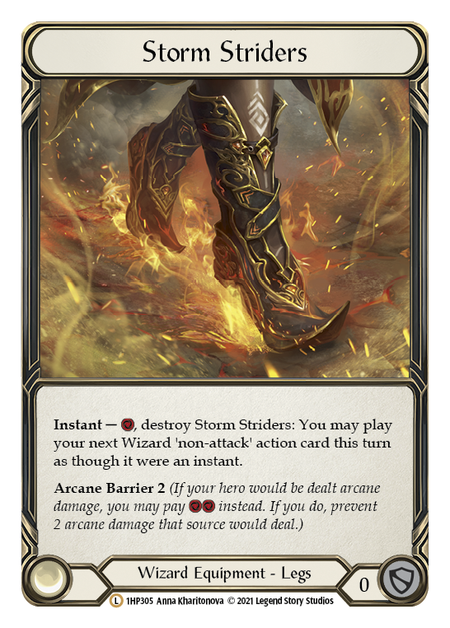
The other default piece of apparel is Fyendal’s Spring Tunic. When compared to other Iyslander lists, you might notice the lack of Alluvion Constellas. I tested Alluvion thoroughly and decided that Tunic was just better for this deck. That single resource every third turn really facilitates some very strong plays, even in the Wizard and Runeblade matchups. Tunic lets you sculpt power turns with Weathervane much more easily, and the value a single extra resource provides in this deck far outweighs the benefits of free Moon activations from Alluvion Constellas. This is my personal preference, but I’ve played hundreds and hundreds of games with this deck and fixed upon Tunic pretty staunchly.
When I first saw the spoiler for Coronet Peak before Uprising was released, I was not impressed. An Ice equipment with 2 defense and blade break was decent, but it’s effect of paying 3 resources and forcing your opponent to pay 1 resource or discard a card, without go again, seemed very inefficient. How could this be a Legendary piece of equipment? It’s basically just a blue Winter’s Bite on a helmet - but Winter’s Bite has go again, so it’s not even as good! Boy was I happy to be wrong. Coronet Peak has become one of my favorite pieces of equipment in the game, and as fas as I’m concerned is one of the most elegantly designed and balanced pieces of gear and should be what LSS strives to reach in balance and functionality. Coronet Peak lets you trade a blue pitch on your turn for a resource from your opponent. As long as they don’t have a Tunic counter at 3, this means they’re forced to at least pitch 1 resource to satisfy Peak and lose 1 potentially valuable card from their hand, forcing them into their turn with 1 less card in hand - effectively turning them into Data Doll for their turn. Stripping a single card from your opponent on your turn means their offense or strategy is disrupted. I use Peak in every matchup but Kano.
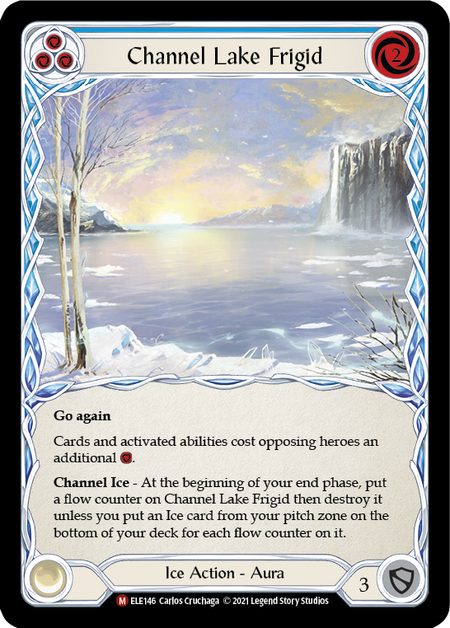
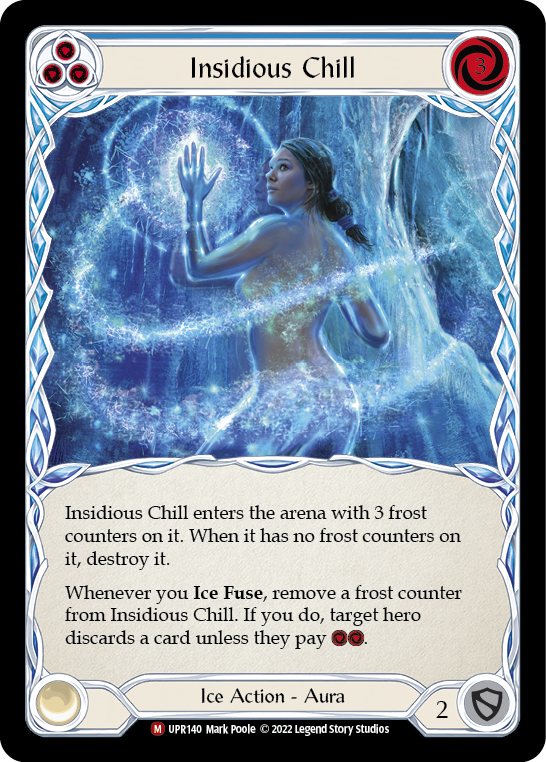
For the arms, I run 2 different gloves: Metacarpus Node and Ironhide Guantlet. Node is a great source of AB:1 and can give you a little damage boost for a key moment. I’ll gladly use Metacarpus Node, when I face off against Dromai, for example; having some way to deal with the bigger Dragons is a must, or even pumping up a Frosting to kill off Kyloria in the layer step, makes Node very effective in the match. Ironhide Guantlet is simply armor, as this deck often has one resource left over on the opponent's turn after playing a 0- or 1-cost action from arsenal and activating Waning Moon.
I run a 51-card main board, meaning 51 cards stay in the deck for every single matchup, regardless of the opposing hero. It's made up of Ice fusions and on-hit disruption, a central theme for the deck.
Ideally, this deck wants to present an action card, fused with an Ice card and paired with an Isenhowl Weathervane. This creates disruption on two fronts: first, it presents arcane damage with various on-hit threats, and second, it creates frostbites that they must answer on their turn if they want to have an offense of their own, hopefully slowing them down significantly. I choose to run 6 Isenhowl Weathervanes in the main deck in red and yellow.
Keeping track of your threat density throughout the game is very important in this deck. The remainder of the deck is made up of 24 blue Ice cards that help facilitate further disruption, keep your blue count high, and ensure you have a fuse target in every hand. But without the threats, your heavy blue card count won't have the gas it needs to close.
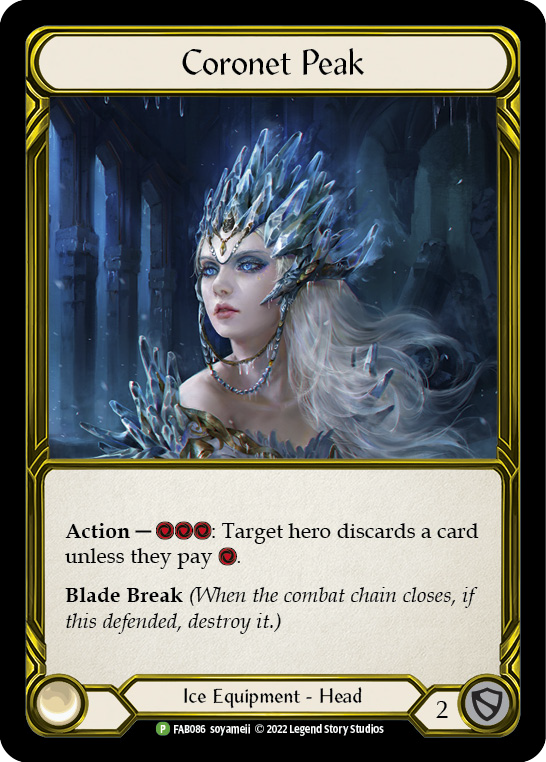
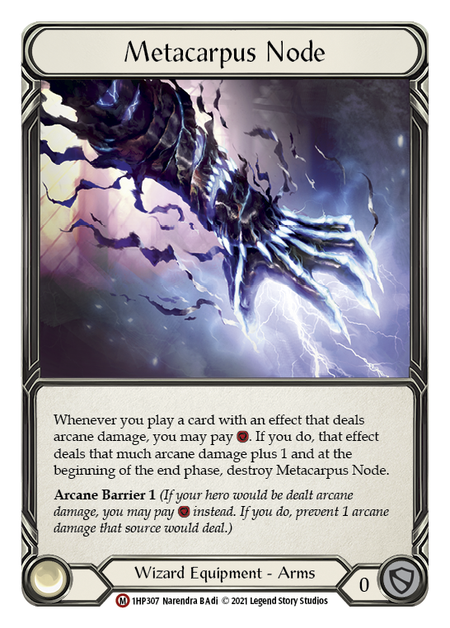
Iyslander has access to the most disruptive cards in the game. Channel Lake Frigid taxes essentially everything your opponent does; and with Iyslander’s hero ability granting her the ability to play blue non-attack action cards on the opponents turn at instant speed, you can easily get an additional turn of CLF on the field. Insidious Chill says your opponent must pay 2 resources or discard a card each time you Ice fuse; coming into play with three counters on it, Iyslander has access to 9 instances of 'pay 2 or discard' effects from Insidious Chills alone. Since we don’t have access to Amulet of Ice anymore, Insidious Chill became that much more important to establish. Normal Iyslander strategies tend to be frugal with their Chill counters, but since this deck wants to be fusing every turn and Insidious Chill triggers are mandatory, it’s pretty difficult to save them.
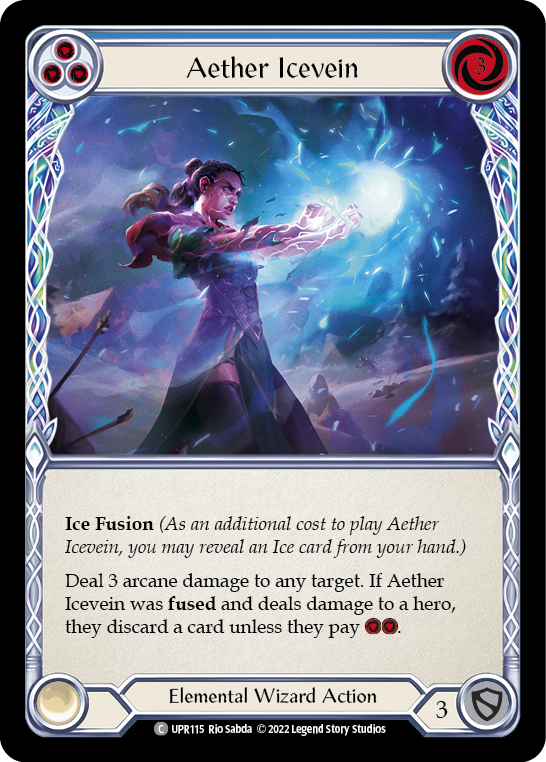
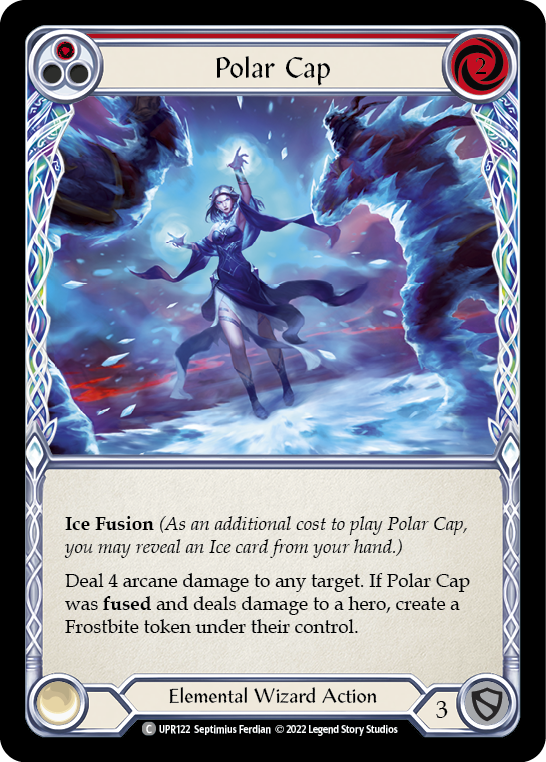
The Weathervane archetype is all about Ice fusing, and all of the major damage cards in the deck do just that. Aether Icevein is one of the most disruptive actions in the game, with an on-hit effect that forces your opponent to “pay 2 or discard”. There isn’t a player in the game who doesn’t cringe every time Iyslander plays it.
Polar Cap is one of the sleeper hits of the deck. I only run the reds - 2 resources for 4 arcane is as much as I'm willing to pay - but if your opponent lets it hit, Polar Cap creates an additional frostbite. At only 2 resources, the math lines up perfectly with Isenhowl Weathervane for 1 blue pitch and a fuse card.
Ice Eternal creates frostbites, then turns those frostbites into a singular source of arcane damage, disrupting your opponents on two fronts. Ice Eternal is one of the most flexible cards in the deck, as a blue that also blocks for 3.
But while Ice Eternal will often be the last thing they see before the end, this deck's true core is Isenhowl Weathervane. Creating multiple frostbites every time you Ice fuse can make Iyslander’s sub par math match even the most efficient of hero strategies.
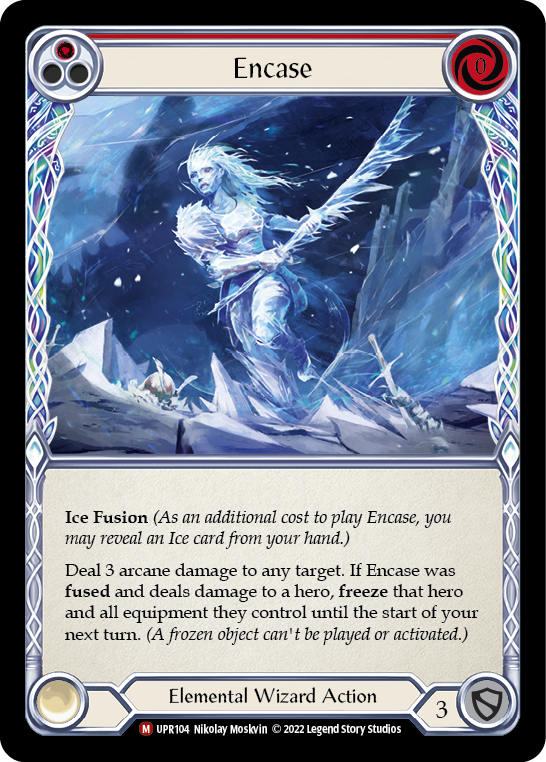
Encase is a 0-for-3 red that, if your opponent lets it hit, is sure to be devastating. Encase freezes that hero and all equipment they control for a turn cycle. The impact of that lost hero power varies, but when it matters it really matters. Not letting Fai tutor up a Phoenix Flame, Lexi flip over her arsenal, or Kano rip cards from the top of his deck means your opponents who don’t respect arcane damage by bringing AB:3 can be very inconvenienced.


Cold Snap is one of my favorite cards in the deck. Played from arsenal on an opponent's turn, it replaces itself, gives a frostbite, and if you pitched a blue card to pay for it, leaves you with 2 resources floating to pay for Waning Moon. If your opponent has an arsenal, Cold Snap taxes them one more resource if they plan on using that arsenal. The value Cold Snap represents is unmatched, plus it lets you cycle through your deck faster.
I love it so much I play blue Polar Blast as well. The text box of Polar Blast might as well be blank, because there are no attacks in the deck to give dominate to; but the card functions much like Cold Snap, letting you draw a card, creating a frostbite for your opponent, and turning on Moon.
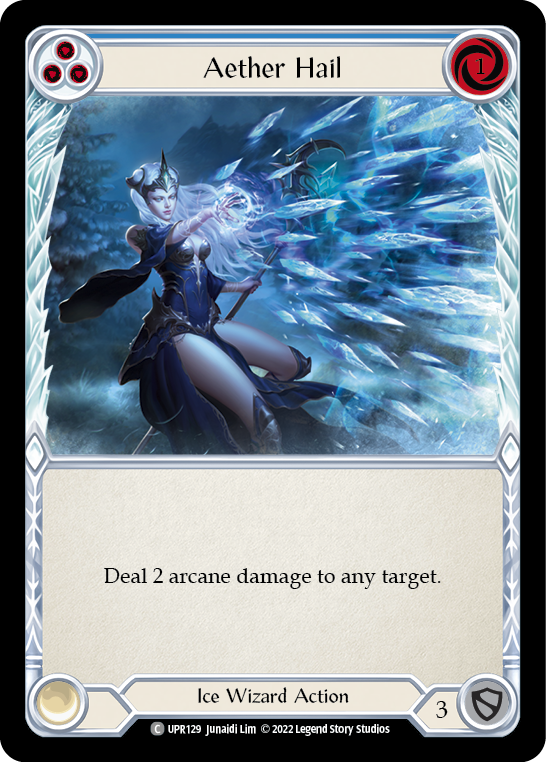
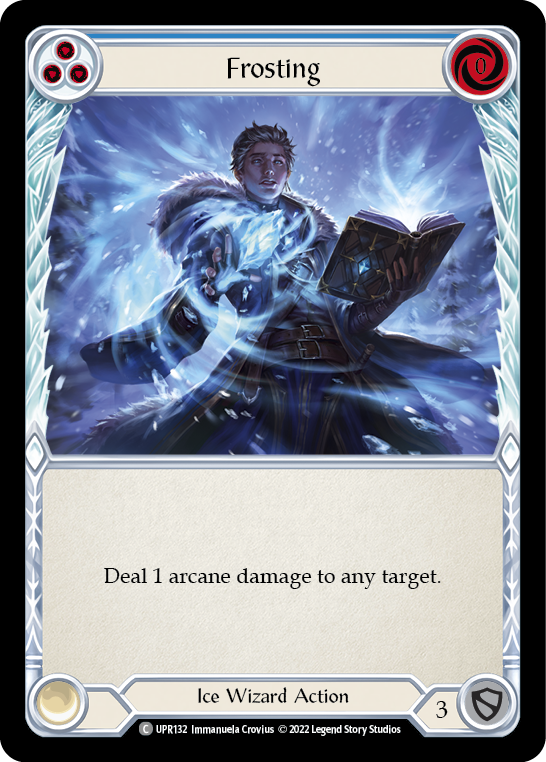
Aether Hail and Frosting can add in a bit of vanilla arcane damage or block for 3, as well as pitch blue and fuse, making them incredibly versatile and utilitarian.

Frost Hex works in tandem with the main strategy of the deck, and can generate massive damage swings every turn that your opponent has very limited ways of dealing with. Establishing a Frost Hex or 2 on your opponent should be of utmost importance.
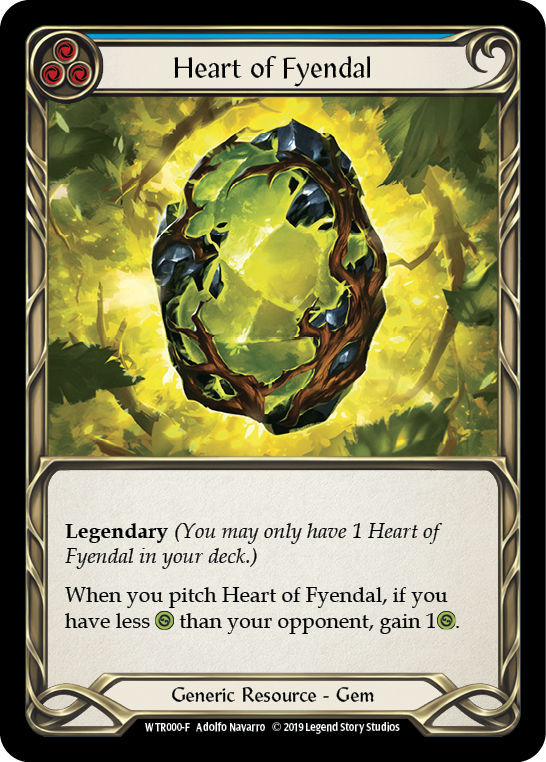
Let’s have a small conversation about Heart of Feyndal. Of all the questions I get about this deck, “Is Heart really necessary?" or “How important is Heart?” are by far the questions I get asked the most. And the answer, for me at least, is…kinda. Flesh and Blood is a game of micro-advantages, and Heart of Feyndal offers just that. Of all the heroes in FaB, I think Iyslander currently utilizes Heart the best - and with this deck’s strategy, that's even more true. She starts the game at a lower life that every other current hero (other than Kano), and she already wants to be pitching blue cards. This deck doesn’t rely on a midrange, block-heavy strategy, being way more proactive than reactive or defensive, so the drawback of Heart not blocking isn’t so much an issue. Plus Iyslander has the ability to drag the game out well past the second or third cycle against some heroes, so you might see Heart come back around a few times, gaining you a life every time you pitch it. I’m not gong to say that it’s necessary to play this deck properly - truth be told, if it wasn’t there I might not even miss it. On the other hand, the amount of games I won with this deck while being at exactly 1 life are far more than I care to admit, with Heart of Feyndal literally saving my ass. So my thoughts are this; while it’s not necessary to the strategy of the deck as little more than a luxury, if you own a Heart, I would 100% run it in the deck; but don’t go out of your way to acquire one just for this deck. I don’t claim to know anything about the secondary market or FaB finance, but I do think Heart of Feyndal is one of the most iconic cards in the game; and with WTR Unlimited being out of print and drying up really fast, there’s only so many of this card in existence in the world that if you do have a desire to own one, now might be the best time to do so. That’s up to you.
I can leave you with some tips on how I sideboard. Cards number 52-54 are always either 3 blue Brain Freeze or 3 blue Icebind. I bring one of those two into every matchup depending on the playstyle or hero I plan on facing. Brain Freeze is amazing against decks that play lots of 0-cost cards such as Fai, Dromai, Dash, Viserai, and Katsu - basically the agro matchups. Likewise, Icebind is better against heroes that Brain Freeze doesn’t effect as much. Icebind is good into the Rangers, threatening a tax on their arsenal. Its better into the Guardians and Warriors who don’t rely on 0-cost Actions as much.
Cards 55-57 as as follows: for the aggro matchups such as Dash, Fai, and Briar, I bring in Blizzard as it’s important to be able to slow them down or shut off go again. For the control or slower matchups, I bring in blue Arctic Incarceration. Combined with 3 Frost Hex, an Arctic Incarceration from arsenal can create 2 frostbites and equal 6 damage for 0 cost.
Cards 58-60 should be your tech cards: Scour, Expose to the Elements, blue Weathervanes, and Fyendal’s Fighting Spirit. Nourishing Emptiness is usually card number 61 in my deck; I only bring it in if I know that my opponent has given three slots to Nullrunes, or otherwise doesn’t run much armor. Unblocked, it can be back breaking, setting you up with up to 6 cards and enabling massive Weathervane and Ice Eternal plays.
Closing
The Weathervane archetype is a very big-risk, big-reward way to play Iyslander. The ceiling potential is massive and the combos and tricks you can pull off with this deck are hugely explosive and super fun to discover. The proactive way Isenhowl Weathervane works requires you to play on a very different axis than a traditional 'boomer' list or more modern Bullander list; and shutting your opponent out of the game has it’s own set of challenges that need to be practiced and learned. This deck might be one of the most challenging and difficult ways to pilot and play Iyslander; but I’ve found, with enough dedication and practice, this deck can win just about any match up you face.
Weathervane is a very different way to play Iyslander and is definitely my favorite, but it’s a deck that takes a lot of practice and dedication to learning the lines and combos possible. I’ve created a YouTube channel where I post gameplay videos and deck techs all based upon this style of playing Iyslander, with hopes of helping further people's interest in this insanely fun archetype. If you’re looking for an interesting, super-powerful and ridiculously fun new way to approach Iyslander, I hope I can convince you to try this deck.




